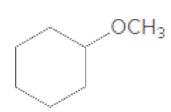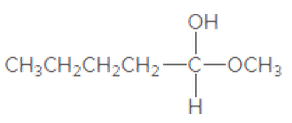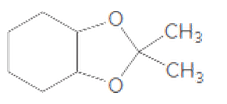
Concept explainers
(a)
Interpretation:
If the given compound is hemiacetal, acetal, or ether should be determined.

Concept Introduction:
The combination of two
(b)
Interpretation:
If the given compound is hemiacetal, acetal, or ether should be determined.

Concept Introduction:
The combination of two functional groups results in the formation of a hemiacetal. In a hemiacetal, a carbon atom is bonded to an alcohol group and an ether group. It is derived from the aldehyde. When two ether and one alcohol group is bonded to a carbon atom, then it results in the formation of acetal. It is derived from hemiacetal.
(c)
Interpretation:
If the given compound is hemiacetal, acetal, or ether should be determined.

Concept Introduction:
The combination of two functional groups results in the formation of a hemiacetal. In a hemiacetal, a carbon atom is bonded to an alcohol group and an ether group. It is derived from the aldehyde. When two ether and one alcohol group is bonded to a carbon atom, then it results in the formation of acetal. It is derived from hemiacetal.
(d)
Interpretation:
If the given compound is hemiacetal, acetal, or ether should be determined.

Concept Introduction:
The combination of two functional groups results in the formation of a hemiacetal. In a hemiacetal, a carbon atom is bonded to an alcohol group and an ether group. It is derived from the aldehyde. When two ether and one alcohol group is bonded to a carbon atom, then it results in the formation of acetal. It is derived from hemiacetal.
Want to see the full answer?
Check out a sample textbook solution
Chapter 16 Solutions
General, Organic, and Biological Chemistry - 4th edition
 Chemistry for Today: General, Organic, and Bioche...ChemistryISBN:9781305960060Author:Spencer L. Seager, Michael R. Slabaugh, Maren S. HansenPublisher:Cengage Learning
Chemistry for Today: General, Organic, and Bioche...ChemistryISBN:9781305960060Author:Spencer L. Seager, Michael R. Slabaugh, Maren S. HansenPublisher:Cengage Learning Chemistry: Principles and PracticeChemistryISBN:9780534420123Author:Daniel L. Reger, Scott R. Goode, David W. Ball, Edward MercerPublisher:Cengage Learning
Chemistry: Principles and PracticeChemistryISBN:9780534420123Author:Daniel L. Reger, Scott R. Goode, David W. Ball, Edward MercerPublisher:Cengage Learning Introductory Chemistry: An Active Learning Approa...ChemistryISBN:9781305079250Author:Mark S. Cracolice, Ed PetersPublisher:Cengage Learning
Introductory Chemistry: An Active Learning Approa...ChemistryISBN:9781305079250Author:Mark S. Cracolice, Ed PetersPublisher:Cengage Learning


